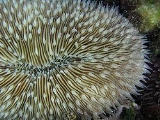
Fungiidae
Encyclopedia
Fungiidae is a family of Cnidaria
. It contains thirteen extant genera
.
animal
s that are capable of benthic locomotion
. These corals often appear to be bleached or dead. In most genera, a single polyp
emerges from the center of the skeleton
to feed at night. Most species remain fully detached from the substrate
in adulthood. Some are immobile as well as colonial
. Mushroom corals are also able to change gender
.
Cnidaria
Cnidaria is a phylum containing over 9,000 species of animals found exclusively in aquatic and mostly marine environments. Their distinguishing feature is cnidocytes, specialized cells that they use mainly for capturing prey. Their bodies consist of mesoglea, a non-living jelly-like substance,...
. It contains thirteen extant genera
Genera
Genera is a commercial operating system and development environment for Lisp machines developed by Symbolics. It is essentially a fork of an earlier operating system originating on the MIT AI Lab's Lisp machines which Symbolics had used in common with LMI and Texas Instruments...
.
Characteristics
Species are generally solitary marineMarine (ocean)
Marine is an umbrella term. As an adjective it is usually applicable to things relating to the sea or ocean, such as marine biology, marine ecology and marine geology...
animal
Animal
Animals are a major group of multicellular, eukaryotic organisms of the kingdom Animalia or Metazoa. Their body plan eventually becomes fixed as they develop, although some undergo a process of metamorphosis later on in their life. Most animals are motile, meaning they can move spontaneously and...
s that are capable of benthic locomotion
Animal locomotion
Animal locomotion, which is the act of self-propulsion by an animal, has many manifestations, including running, swimming, jumping and flying. Animals move for a variety of reasons, such as to find food, a mate, or a suitable microhabitat, and to escape predators...
. These corals often appear to be bleached or dead. In most genera, a single polyp
Polyp
A polyp in zoology is one of two forms found in the phylum Cnidaria, the other being the medusa. Polyps are approximately cylindrical in shape and elongated at the axis of the body...
emerges from the center of the skeleton
Skeleton
The skeleton is the body part that forms the supporting structure of an organism. There are two different skeletal types: the exoskeleton, which is the stable outer shell of an organism, and the endoskeleton, which forms the support structure inside the body.In a figurative sense, skeleton can...
to feed at night. Most species remain fully detached from the substrate
Substrate (marine biology)
Stream substrate is the material that rests at the bottom of a stream. There are several classification guides. One is:*Mud – silt and clay.*Sand – Particles between 0.06 and 2 mm in diameter.*Granule – Between 2 and 4 mm in diameter....
in adulthood. Some are immobile as well as colonial
Colonisation
Colonization occurs whenever any one or more species populate an area. The term, which is derived from the Latin colere, "to inhabit, cultivate, frequent, practice, tend, guard, respect", originally related to humans. However, 19th century biogeographers dominated the term to describe the...
. Mushroom corals are also able to change gender
Gender
Gender is a range of characteristics used to distinguish between males and females, particularly in the cases of men and women and the masculine and feminine attributes assigned to them. Depending on the context, the discriminating characteristics vary from sex to social role to gender identity...
.
Genera
- Ctenactis
- CantharellusCantharellusCantharellus is a genus of popular edible mushrooms, commonly known as chanterelles . They are mycorrhizal fungi, meaning they form symbiotic associations with plants, making them very difficult to cultivate...
- Cycloseris
- Diaseris
- Fungia
- Halomitra
- Heliofungia
- Herpolita
- Lithophyllon
- Podabacia
- Polyphyllia
- Sandalolitha
- Zoopilus
Notable species
- One fungiid species, Heliofungia actiniformis ("anemone coral"), can be easily mistaken for a sea anemoneSea anemoneSea anemones are a group of water-dwelling, predatory animals of the order Actiniaria; they are named after the anemone, a terrestrial flower. Sea anemones are classified in the phylum Cnidaria, class Anthozoa, subclass Zoantharia. Anthozoa often have large polyps that allow for digestion of larger...
[actiniarian] because its tentacleTentacleA tentacle or bothrium is one of usually two or more elongated flexible organs present in animals, especially invertebrates. The term may also refer to the hairs of the leaves of some insectivorous plants. Usually, tentacles are used for feeding, feeling and grasping. Anatomically, they work like...
s remain visible during the day. - Fungia spp. have a commensal pipefishPipefishPipefishes or pipe-fishes are a subfamily of small fishes, which, together with the seahorses, form the family Syngnathidae.-Anatomy:...
, Siokunichthys nigrolineatus. - Some fungiids can be elongate and look like a sea cucumber (stichopodidStichopodidaeStichopodidae is a family of echinoderms; its members are known as sea cucumbers.-Genera:* Apostichopus* Isostichopus * Parastichopus * Stichopus * Thelenota* Australostichopus-External links:...
). - Some fungiids (Fungia scruposaFungia scruposaFungia scruposa is a species of coral that is the first to have been observed to eat jellyfish. They are around 25 cm in diameter and normally eat a variety of food from bacteria to mesozooplankton measuring 1 mm in diameter. During an algal bloom in 2009 researchers observed the coral...
) have been observed eating jellyfish.

